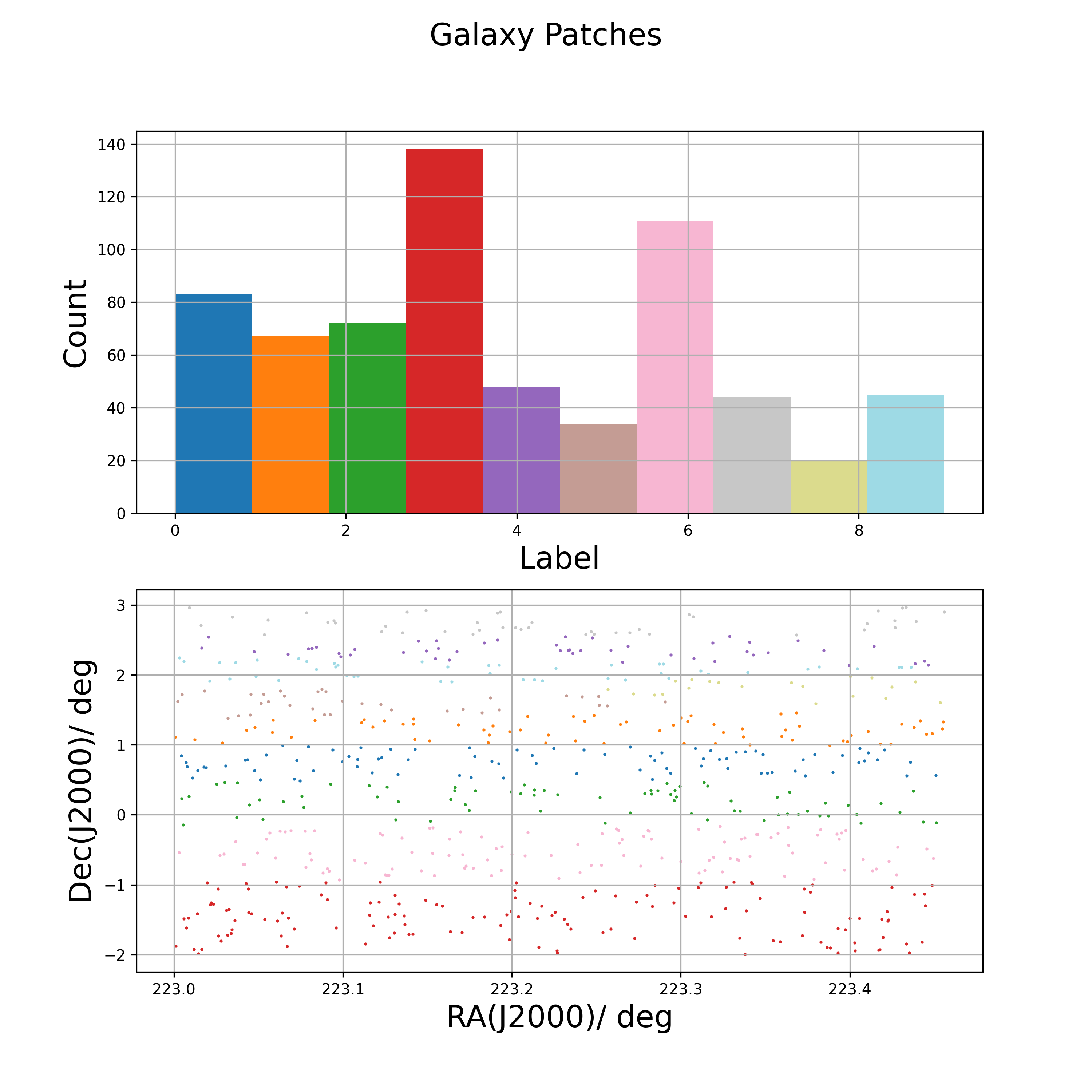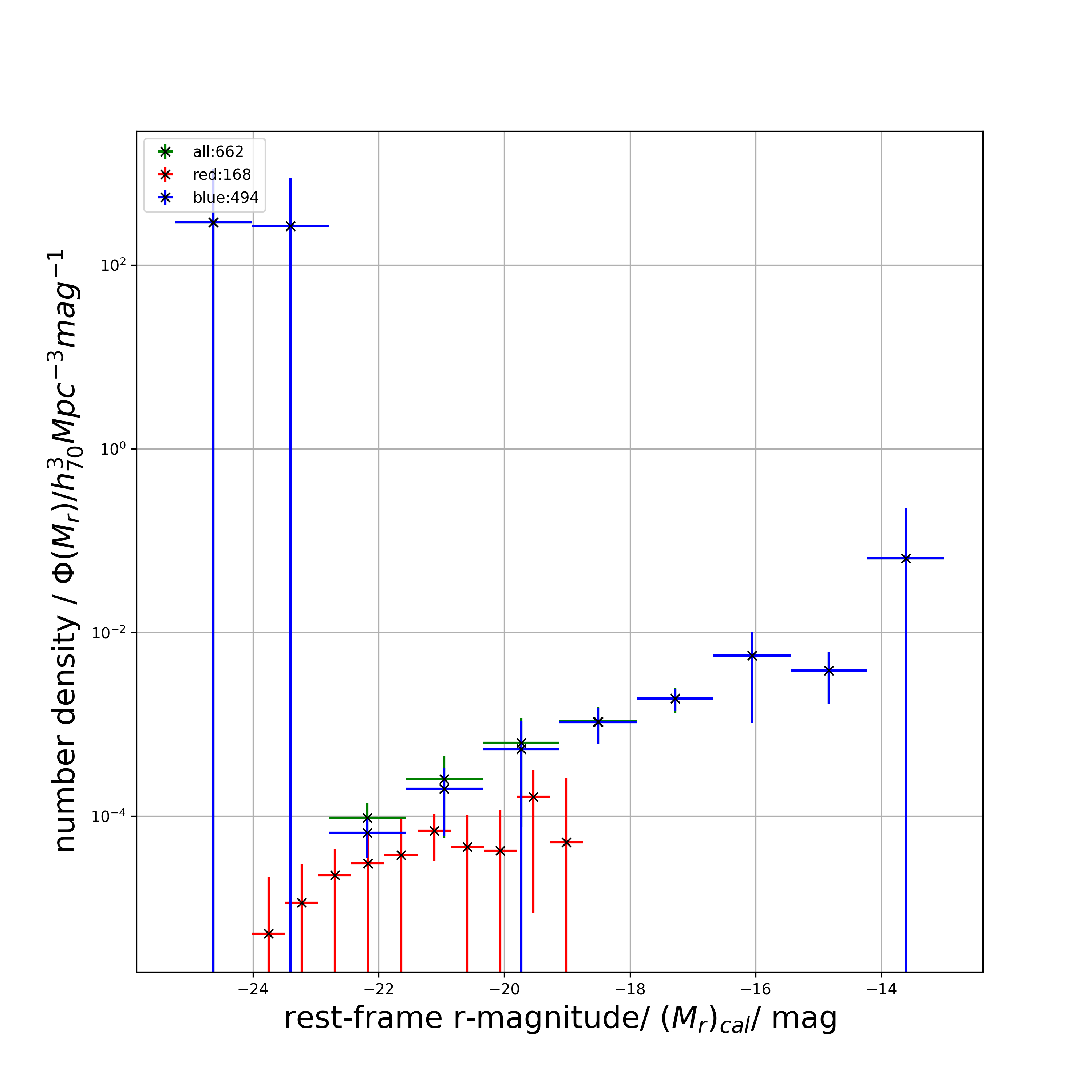Galaxian Luminosity Function Constructor package using the 1/Vmax estimator and Schechter model.
Project description
Luminosity Function Constructor and Modeller
This package allows the user to construct and model Galaxian Luminosity Functions using the <img src="https://render.githubusercontent.com/render/math?math=\frac{1}{V_{max}}" alt=:"1/Vmax"> estimator and Schechter function.
Installation
Use the package manager pip to install lumfunc.
pip install lumfunc
Keep the package up to date to access all commands.
pip install --upgrade lumfunc
Usage
Import the module in your Python code.
import lumfunc as lf
Load the catalogued data from survey. Usually stored in .fits or .csv files.
import numpy as np
import pandas as pd
# test data (photometric galaxian survey)
data_table = pd.read_csv('test_catalogue.csv')
RA_list = np.array(data_table['RA'])
Dec_list = np.array(data_table['Dec'])
g_app_mag_list = np.array(data_table['g_mag'])
r_app_mag_list = np.array(data_table['r_mag'])
r_app_mag_err_list = np.array(data_table['r_mag_err'])
z_photo_list = np.array(data_table['z_photo'])
K-correction and Malmquist bias reduction:
get_maggy( ): Convert the measurements of flux in magnitudes to maggies for use with kcorrect_python
Return maggies from magnitudes.
r_maggies_list = lf.get_maggy(r_app_mag_list)
print(r_maggies_list[0:4])
# returns
# [2.17126084e-08 1.88972757e-08 9.39864400e-09 3.74726494e-08]
# rudimentarily:
lf.get_maggy(np.array([19.15822, 19.309002, 20.067337, 18.565714]))
# returns
# array([12.17126084e-08, 1.88972757e-08, 9.39864400e-09, 3.74726494e-08])
get_maggy_inv_var( ): Convert the magnitude errors to maggy inverse variances for use with kcorrect_python
Return maggy inverse variances from maggies and magnitude errors.
r_maggy_inv_var_list = lf.get_maggy_inv_var(r_maggies_list, r_app_mag_err_list)
print(r_maggy_inv_var_list[0:4])
# returns
# [2.61353653e+20 2.21539925e+20 2.63295704e+20 1.52030876e+20]
# rudimentarily:
lf.get_maggy_inv_var(
np.array([2.17126084e-08, 1.88972757e-08, 9.39864400e-09, 3.74726494e-08]),
np.array([0.00309313, 0.0038601, 0.0071193, 0.00234987]))
# returns
# array([2.61353484e+20, 2.21540499e+20, 2.63295631e+20, 1.52031005e+20])
get_rest_mag( ): Convert the measured apparent magnitudes into rest-frame magnitudes using the catalogue data and output from kcorrect_python functions
Load maggy ratios output file from kcorrect_python.
maggy_ratios_table = pd.read_csv('test_maggy_ratios.csv', delimiter=' ')
r_maggy_ratio_list = np.array(maggy_ratios_table['maggy_ratio'])
Return rest-frame magnitudes from the apparent magnitudes, redshifts and maggy ratios.
r_rest_mag_list = lf.get_rest_mag(z_photo_list, r_app_mag_list, r_maggy_ratio_list)
print(r_rest_mag_list[0:4])
# returns
# [-22.50048222 -20.3671756 -23.61190368 -23.75133511]
# rudimentarily:
lf.get_rest_mag(np.array([0.34, 0.17, 0.61, 0.41]),
np.array([19.15822, 19.309002, 20.067337, 18.565714]),
np.array([0.69938735, 0.90226577, 0.43780755, 0.59193305]))
# returns
# array([-22.50048222, -20.3671756 , -23.61190369, -23.75133512])
get_volume( ): Convert the survey area in square degrees and respective redshift of each data point into comoving volumes. So, estimate  from
from  values
values
Load 
zmax_table = pd.read_csv('test_zmax.csv', delimiter=' ')
z_max_list = np.array(zmax_table['zmax'])
Return comoving volume from the survey area and redshifts.
survey_area = 2.5 #sq. degrees
Vmax_list = lf.get_volume(survey_area, z_max_list)
print(Vmax_list[:4])
# returns
# [1756716.17902236 178625.22666027 2447025.54638078 2287569.96087901]
# rudimentarily:
lf.get_volume(2.5, np.array([0.50523681, 0.21884399, 0.57489149, 0.55985663]))
# returns
# array([1756716.14859094, 178625.22895137, 2447025.56779186, 2287569.99514156])
get_binned_phi( ): Bin and weigh galaxy counts per magnitude by 
Return M, M errors and phi from the rest-frame magnitudes, 
n_bins = 10
M_list, M_err_list, phi_list = lf.get_binned_phi(r_rest_mag_list, Vmax_list, n_bins)
print(M_list)
# returns
# [-25.1487769 -23.86987184 -22.59096677 -21.31206171 -20.03315665
# -18.75425159 -17.47534652 -16.19644146 -14.9175364 -13.63863134]
print(M_err_list)
# returns
# [0.63945253 0.63945253 0.63945253 0.63945253 0.63945253
# 0.63945253 0.63945253 0.63945253 0.63945253 0.63945253]
print(phi_list)
# returns
# [2.78118218e+02 2.54476157e+02 6.57347457e-05 1.98257155e-04 4.84943102e-04
# 1.02149157e-03 1.49165665e-03 4.54012724e-03 5.08195775e-03 6.14432455e-02]
# OR a rudimentarily example:
lf.get_binned_phi(
np.array([-23, -21, -19, -22, -23, -23, -22, -23, -22, -22, -19, -21]),
np.array([
8e+08, 2e+08, 2e+07, 3e+08, 6e+08, 6e+08, 4e+08, 7e+08, 5e+08, 6e+08,
7e+06, 1e+08
]), 4)
# returns
# (array([-22.5, -21.5, -20.5, -19.5]),
# array([0.5, 0.5, 0.5, 0.5]),
# array([1.06411667e-08, 1.02900000e-08, 0.00000000e+00, 1.32300000e-07]))
Spatial variances of the phi,  , values:
, values:
get_patch_centers( ): First, divide uniformly and randomly simulated data points over the survey area into equally distributed and equally sized patches
Load RA and Dec from uniformly distributed catalogue.
Return patch centers as (RA, Dec) from the RA, Dec and number of patches.
n_patches = 10
centers_array = lf.get_patch_centers(uniform_RA_list,
uniform_Dec_list,
n_patches,
survey='kids',
max_iterations=int(100),
tolerance=1.0e-1)
print(centers_array)
# returns
# [[ 2.23226392e+02 -6.47337713e-01]
# [ 2.23174491e+02 5.98874609e-01]
# [ 2.23206303e+02 2.54474739e+00]
# [ 2.23364832e+02 2.27454560e-02]
# [ 2.23226123e+02 -1.04628927e+00]
# [ 2.23223194e+02 1.83340758e+00]
# [ 2.23203976e+02 2.80451675e-01]
# [ 2.23250395e+02 1.05613678e+00]
# [ 2.23223566e+02 -2.53662998e-01]
# [ 2.23206029e+02 -1.61910398e+00]]
get_patch_labels( ): Then, use the patch centers to label the survey data points by equally distributed and equally sized patches
Return patch labels for each data point from RA, Dec, number of patches and patch center guesses.
labels = lf.get_patch_labels(RA_list,
Dec_list,
n_patches,
centers_array,
survey='kids',
numba_installed=True,
plot_savename='test_patches.png')
# displays plot
get_binned_phi_error( ): Finally, use the patch labels to compute the spatial variances of 
Return error on phi from rest-frame magnitude, maximum observed volume, labels, number of patches and number of bins.
phi_err_list = lf.get_binned_phi_error(r_rest_mag_list, V_list, labels, 10, 10)
print(phi_err_list)
# returns
# [5.94527087e+02 5.32152271e+02 5.38376011e-05 1.08222758e-04 3.44129217e-04
# 6.73400063e-04 4.78645493e-04 4.11111879e-03 1.42161638e-02 1.44288277e-01]
Visualisation:
get_plot( ): Perform get_binned_phi() , get_patches() and get_binned_phi_error() functions using only one composite function and visualise the luminsoity function
Plot the <img src="https://render.githubusercontent.com/render/math?math=\frac{1}{V_{max}}" alt=:"1/Vmax"> weighted luminosity function, binned by magnitude.
M_list, M_err_list, phi_list, phi_err_list = lf.get_plot(
r_rest_mag_list,
Vmax_list,
n_bins,
RA_list,
Dec_list,
n_patches,
centers_array,
survey='kids',
numba_installed=True,
plot_savename='test_LF.png')
# displays plot
filter_plot_by_colour( ): Study the luminosity function by colour properties by specifying the colour dichotomy
Plot the <img src="https://render.githubusercontent.com/render/math?math=\frac{1}{V_{max}}" alt=:"1/Vmax"> weighted luminosity function from data, binned by magnitude and filtered by galaxy colours. The galaxy colours are filtered by red and blue with the help of the input colour dichotomy line parameters. The colour dichotomy line parameters must be inferred first from a CMD plot.
colour_cut_slope = 0.0
colour_cut_intercept = 0.65
all_M_list, all_M_err_list, all_phi_list, all_phi_err_list, red_M_list, red_M_err_list, red_phi_list, red_phi_err_list, blue_M_list, blue_M_err_list, blue_phi_list, blue_phi_err_list = lf.filter_plot_by_colour(
colour_cut_slope,
colour_cut_intercept,
r_rest_mag_list,
g_rest_mag_list,
V_list,
n_bins,
RA_list,
Dec_list,
n_patches,
centers_array,
survey='kids',
numba_installed=True,
plot_savename='test_LF_colour.png')
# displays plot
Modelling with Schechter functions:
SchechterMagModel( )
Return single Schechter luminosity function in terms of magnitude from 3 free parameters of the model.
M_star_guess = -20.7
phi_star_guess = 9.5e-3
alpha_guess = -1.3
sch1_model_phi_list = lf.SchechterMagModel(M_list, M_star_guess, phi_star_guess, alpha_guess)
print(sch1_model_phi_list)
# returns
# [1.85685848e-29 3.25671139e-11 1.72458831e-05 1.27468679e-03 6.12395219e-03
# 1.26803536e-02 2.02617665e-02 2.98927403e-02 4.30310959e-02 6.14770530e-02]
DoubleSchechterMagModel( )
Return double Schechter luminosity function in terms of magnitude from 5 free parameters of the model.
M_star_guess = -20.7
phi_star_1_guess = 6.16e-3
alpha_1_guess = -0.79
phi_star_2_guess = 6.16e-3
alpha_2_guess = -0.79
sch2_model_phi_list = lf.DoubleSchechterMagModel(M_list, M_star_guess,
phi_star_1_guess,
alpha_1_guess,
phi_star_2_guess,
alpha_2_guess)
print(sch2_model_phi_list)
# returns
# [1.94632963e-28 1.87206201e-10 5.43662983e-05 2.20369342e-03 5.80607779e-03
# 6.59304119e-03 5.77743541e-03 4.67441094e-03 3.69017477e-03 2.89121864e-03]
get_gof( ): Estimate the goodness of the fit by the reduced chi square,  )
)
Returns reduced chi squared estimate of goodness of fit from observed values, modelled values, errors and number of free parameters used in model.
gof = lf.get_gof(phi_list, phi_err_list, sch1_model_phi_list, 3)
print(gof)
# returns
#
get_schechter_phi( ): Least square fit single Schechter function on data and plot
Returns least square fit of phi with single Schechter function, reduced chi squared estimate and the 3 Schechter parameters with their errors.
sch1_model_phi_list, chi_sq_1, M_star, M_star_err, phi_star, phi_star_err, alpha_star, alpha_star_err = lf.get_schechter_phi(
M_list,
M_err_list,
all_phi_list,
all_phi_err_list,
np.array([M_star_guess, phi_star_guess, alpha_guess]),
plot_savename='test_Sch.png')
# displays plot
get_double_schechter_phi( ): Least square fit double Schechter function on data and plot
Returns least square fit of phi with double Schechter function, reduced chi squared estimate and the 5 Schechter parameters with their errors.
sch2_model_phi_list, chi_sq_1, M_star, M_star_err, phi_star_1, phi_star_err_1, phi_star_2, phi_star_err_2, alpha_star_1, alpha_star_err_1, alpha_star_2, alpha_star_err_2 = lf.get_double_schechter_phi(
M_list,
M_err_list,
all_phi_list,
all_phi_err_list,
np.array([M_star_guess, phi_star_1_guess, alpha_1_guess, phi_star_2_guess, alpha_2_guess]),
plot_savename='test_dSch.png')
# displays plot
Dependencies




Contributing
Pull requests are welcome. For major changes, please open an issue first to discuss what you would like to change.
Please make sure to update tests as appropriate.
License
Project details
Release history Release notifications | RSS feed
Download files
Download the file for your platform. If you're not sure which to choose, learn more about installing packages.
Source Distribution
Built Distribution
File details
Details for the file lumfunc-0.2.7.tar.gz.
File metadata
- Download URL: lumfunc-0.2.7.tar.gz
- Upload date:
- Size: 3.0 MB
- Tags: Source
- Uploaded using Trusted Publishing? No
- Uploaded via: twine/3.2.0 pkginfo/1.5.0.1 requests/2.23.0 setuptools/42.0.2 requests-toolbelt/0.9.1 tqdm/4.43.0 CPython/3.7.6
File hashes
| Algorithm | Hash digest | |
|---|---|---|
| SHA256 | 531327b455081d41b737d0a964790473f8c584a6f3ed83e8ec494dd5ba535d93 |
|
| MD5 | f5579779e594eabd5573e8bbf11e6582 |
|
| BLAKE2b-256 | 632d3874f3412d6d8d2cf1e56e29f7d87acc86a5679e2340fc0854e25d1e1ac6 |
File details
Details for the file lumfunc-0.2.7-py3-none-any.whl.
File metadata
- Download URL: lumfunc-0.2.7-py3-none-any.whl
- Upload date:
- Size: 16.7 kB
- Tags: Python 3
- Uploaded using Trusted Publishing? No
- Uploaded via: twine/3.2.0 pkginfo/1.5.0.1 requests/2.23.0 setuptools/42.0.2 requests-toolbelt/0.9.1 tqdm/4.43.0 CPython/3.7.6
File hashes
| Algorithm | Hash digest | |
|---|---|---|
| SHA256 | 470cabb989497efacff70ede924b1645e72f9d0c40f775fbfa2ec6e9789c6432 |
|
| MD5 | 147edf52ccd6f3b38346f74253fac848 |
|
| BLAKE2b-256 | 0d1285b144d1627b2e81756fa69af6ebfca3f0706ce20465c3855e870da0742e |
























